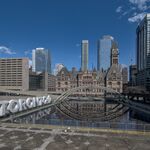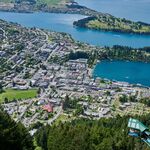It is ridiculous that the left turn signal for a few cars take priority over the hundreds of riders on the train. By simply placing the left turn phase after straight traffic, the same amount of cars still get through each cycle with the benefit of shaving off a few minutes. This city is so backwards.
Advanced left-turn phase is supposedly done for the safety of pedestrians. The reasoning is that if the left-turn phase comes after the straight phase (when the pedestrians are crossing too), then some of the pedestrians may still be in the road lanes when the left-turn phase begins and the cars are rushing to complete their left turn and might hit them. I don't know how much the advanced left-turn actually helps though.
In any case, simply changing the sequence of transit phases will not necessarily improve the LRT's average travel time. Yes, the optics will be better; LRT crosses first, while the cars wait.
But in fact, it is possible that the LRT will not finish the boarding before the end of the straight phase and will not be able to cross until the next cycle. While if the advanced left-turn phase was in place, the LRT would finish the boarding during that phase, and then cross during the straight phase.
I'm thinking, a better option is to give the LRT more chances to cross. That could be achieved by adding a short LRT-only straight phase, active only when the LRT is present. For example, the Eglinton & Warden phases would be:
1. Warden straight
2. Eglinton LRT-only, lasts about 20 seconds, regular traffic does not go (would be too confusing to stop it after 20 s)
3. Eglinton left-turns
4. Eglinton straight (LRT can cross during this phase, too)
5. Warden left-turns
[and the cycle repeats]







